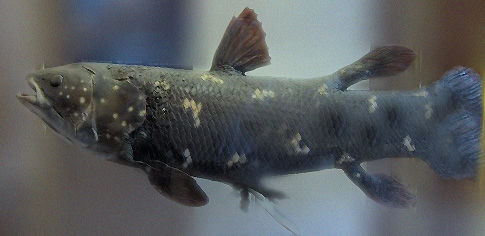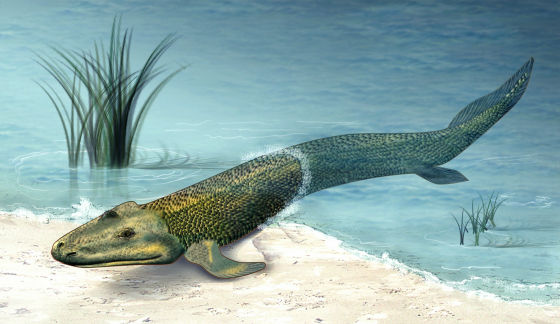Why did mankind's ancestor advance from land to land? A new research result is revealed to overturn the theory about the mystery of

ByLeigh Jay Temple
Approximately 400 million years ago, when the ancestral fish of mankind advanced from the sea to the land, it was necessary to develop the fins like a limb, but the definitive cause that encouraged this evolution is grasped even in 2018 Where not. "Floods" and "droughts" occurred, and fish were pushed out to the land, did not they develop the fins like feet trying to return to the water? And that it was advantageous for obstacles in the water, did not it develop? Although studies are being considered, the research showed the possibility that it was caused not by floods or drought but "tide fullness".
Strong tides may have pushed ancient fish to evolve limbs | Science | AAAS
http://www.sciencemag.org/news/2018/02/strong-tides-may-have-pushed-ancient-fish-evolve-limbs
Ocean tides could have driven ancient fish to walk
https://www.nature.com/articles/d41586-018-02034-w
Fish considered as human ancestry is "Pectoral fin"(Hikikiko) The name is called" flesh fruit "(Kukuki). Pinus roots include coelacanth and Hijyo and such fishes are characterized by thick fillets like feet. After the fins rose to the land from the sea 400 million years ago, four fillets changed like feet and laterLimb animalIt is thought that it branched to various creatures including mankind from there.

The common belief up to now is that the cause of the petrochemical entrance into the land was seen as flood or drought. In other words, it is said that as the fins rose into the puddle due to the flood and moved from there, the fins looked like feet and corresponded to land. On the other hand, the hypothesis announced this time makes the tide full of the cause of the advancement of the petiola, "tidal". The tide lowers the sea level, after the petrocine stranding to land, the fillet evolves like a foot in order to return to the water and from there there is more advantage than returning to the sea if you are in the land It is the idea that it evolved further in a form adapted to the land by.

This hypothesis was announced on February 15 (Thursday) in 2018 by "Ocean Sciences Meeting", a research team of marine scientist Matthias Green, belonging to the University of Bangor in the UK. The hypothesis was based on the fact that as a result of simulation of the ancient Earth, "the place where the fossil of the petiola was found and the point where the strong tide was full" was the same. Mr. Green, who announced this hypothesis, said, "In the common opinion fish enters the puddle and the fins have turned into feet from there, but whether a puddle is born, the fish go into it, and the puddle dries up It was a mystery, "arguing that it does not happen if the doubt of the common opinion is this hypothesis.
In the past, there was a hypothesis that the fish 's advance on the ground was inspired by the tide fullness like this time was announced. At the time of the 20th century, the paleontologist Alfred Romer of the University of Chicago announced that there is a possibility that tide filling may have spurred the evolution of an early quadrupedal walking animal. Later, in 2014, astrophysicist Oxford University astronomical physicist Steven Valves announced another theory to advance this hypothesis. According to Mr. Valves, 400 million years ago, the distance between the Moon and the Earth was close to 10 percent. From this, it is said that the tide that occurred when the sun, moon, and the earth were on a straight line was stronger than the current earth. Mr. Valves showed that the fish were stranded at a specific point on the coastline each time a strong tidal wave had occurred every two weeks.

ByKhuroshvili Ilya
Mr. Green said, "Evolution was encouraged, and in the tide of stranded water, the fish tried to eat and move to escape into the water from there. In this state Then, it is more advantageous to have a big fillet like four legs to return to water. "
However, there have been changes in the terrain of the earth for hundreds of millions of years, and it was a challenge to gather evidence to prove the above theory in modern times. The land of the earth 400 million years ago, the northRolasia ContinentAnd southGondwana continentIt was composed of two supercontinents called. When comparing these with the current land, the position changed with the plate of the stratum, and the shape of the coastline changed due to seawater erosion.

In order to solve this problem, Mr. Green et al. Created a model of the supercontinent 400 million years ago and simulated the tide-induced coastline change. Then, we learned that the wedge-shaped sea and the seabed terrain are born by the separation of the supercontinent.
In the simulation, we recorded various parts of the coastline that changed, and the research team revealed the point where the fish is easy to strangle. This point will show the consistency of the theory as the fish coincides with the fossil point found. For example, the big fossils in Today's Eastern Europe, Canada, and Ireland and the greatly hollowed areas are that the points at which the stranding occurred agree exactly. About this, Mr. Green commented, "I am happy that I can not finish this."
In addition, the simulation showed a new point that a massive number of fossils that were not known until now would be excavated. However, according to Hanna Baan, an oceanographer at Uppsala University in Sweden who led the modeling of the simulation, "It is difficult to find out because these places are politically unstable."
Related Posts:
in Science, Posted by darkhorse_log







